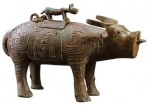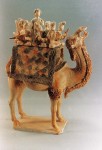Shaanxi History Museum
 The Shaanxi History Museum is situated on Yan Ta Road in Xi’an City, Shaanxi Province. It covers 65,000 square meters, with a building area of 60,000 square meters. The newly built modern building recreates Tang-dynasty architecture and successfully symbolizes the great extent of Shaanxi history and its remarkable culture.
The Shaanxi History Museum is situated on Yan Ta Road in Xi’an City, Shaanxi Province. It covers 65,000 square meters, with a building area of 60,000 square meters. The newly built modern building recreates Tang-dynasty architecture and successfully symbolizes the great extent of Shaanxi history and its remarkable culture.
Exhibited in the main exhibition hall are 2,700 works of art, with an  exhibition line that extends 2,300 meters. The exhibition space is divided into an introductory hall, permanent exhibitions, special exhibitions, and temporary exhibitions, as well as one that has been named the National Painting Hall.
exhibition line that extends 2,300 meters. The exhibition space is divided into an introductory hall, permanent exhibitions, special exhibitions, and temporary exhibitions, as well as one that has been named the National Painting Hall.
The Museum’s permanent exhibition primarily displays Shaanxi’s ancient history. Representative pieces from all periods have been selected to show the development of civilization in this region. The exhibition space of this display is 4,600 square meters. It includes three exhibition rooms, divided into seven parts (Prehistory, Zhou, Qin, Han, Wei-Jin-North and South dynasties, Sui-Tang, and Song-Yuan-Ming-Qing). The superlative 2,000 selected objects include: painted Neolithic ceramics reflecting early people’s living conditions and their pursuit of vibrant art forms, bronzes reflecting the rise of Zhou people, bronze weapons including swords, and statuary of horses and soldiers, reflecting the way in which Qin unified all under heaven, Tang-dynasty gold and silver objects and Tang sancai (tri-colored pottery of Tang dynasty) ceramics, reflecting the most flourishing period of feudal glory. All of this is accompanied by models of archaeological sites, and drawings, and photographs. These works systematically exhibit the ancient history of Shaanxi from 150,000 years ago to the year 1840. Since several historical periods all based their capitals on Shaanxi territory, such as Zhou, Qin, Western Han, Sui and Tang, the exhibits emphasize these periods and these places. This not only expresses the extent of culture in ancient Shaanxi, it also displays the highest level of cultural development of China’s social economy.
 The temporary exhibits hall, located on the east side of the museum, has had a variety of exhibitions including Tang-tomb wall paintings, that is to say 39 of the actual paintings. Shaanxi’s wall murals of this kind rank first in the entire country. They are fluid in concept and line, they have marvelous details, and they both depict Tang customs and are superb works of art.
The temporary exhibits hall, located on the east side of the museum, has had a variety of exhibitions including Tang-tomb wall paintings, that is to say 39 of the actual paintings. Shaanxi’s wall murals of this kind rank first in the entire country. They are fluid in concept and line, they have marvelous details, and they both depict Tang customs and are superb works of art.
The special exhibition hall is located on the west side of the museum. Its first two exhibitions were a Shaanxi bronzes exhibit (260 were on display) and a Shaanxi-through-the-dynasties terracotta masterpieces exhibit (341 objects were exhibited). The area of this hall is around 2,600 square meters.
The Shaanxi History Museum contains 115,000 objects in its collections. The more representative of these include bronzes, Tang-dynasty tomb wall paintings, terracotta statuary, ceramics (pottery and porcelain), construction materials through the dynasties, Han and Tang bronze mirrors, and coins and currency, calligraphy, rubbings, scrolls, woven articles, bone articles, wooden and lacquer and iron and stone objects, seals, as well as  some contemporary cultural relics and ethnic objects.
some contemporary cultural relics and ethnic objects.
Address: Shaanxi Province, Xi’an City, Yanta Road, #70